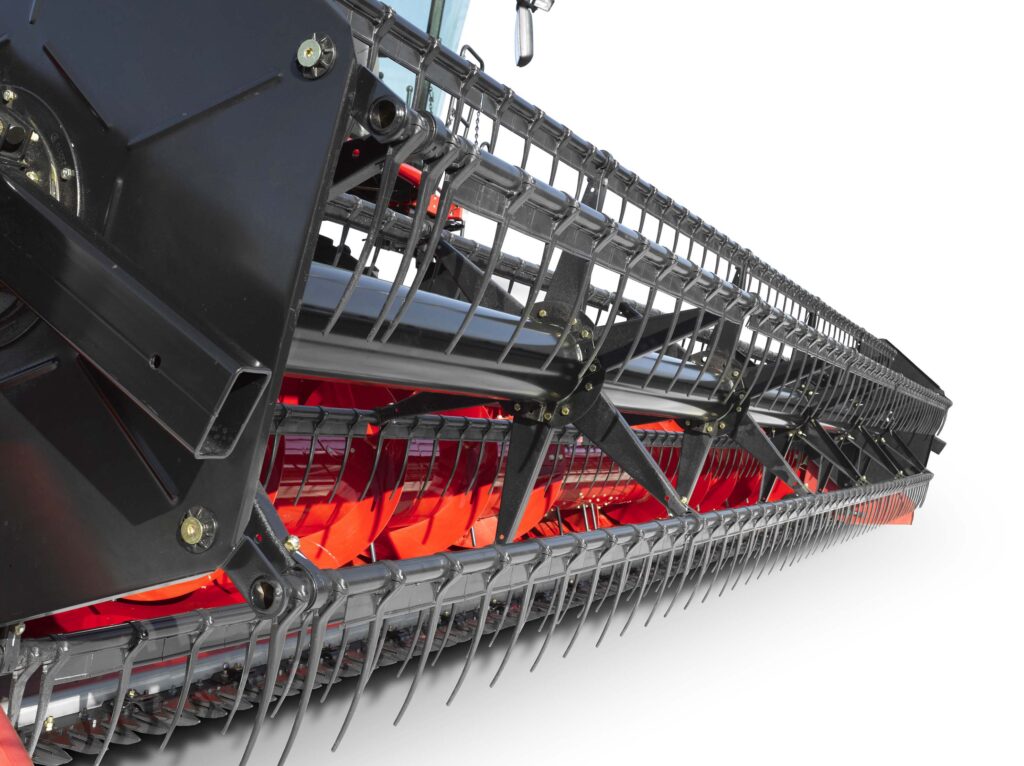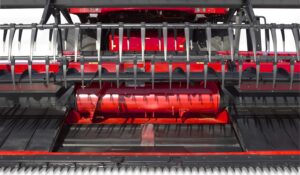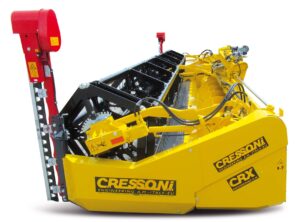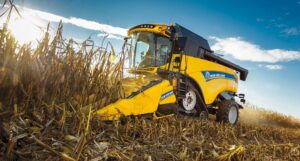The combine header is essential for harvesting products in the open field. Since each crop has particular needs, it is essential to use a specific header of the latest generation
by Pier Luigi Scevola

The photo highlights the large reel, the blade holder tines, the toothed blade, the screw conveyor with opposing spiral and retractile fingers of a very modern grain header (Photo credits: CASE IH)
The combine harvester is a prodigious machine that reaps, threshes and temporarily stores the harvested product in a single pass. It can also shred straw or stems, or recompose them into well-structured windrows before their pressing with balers. The combine harvester, therefore, has the task of carrying out all the operations with the utmost precision, avoiding product losses that would seriously damage the company’s balance sheets. A fundamental device to carry out the harvesting with the utmost precision is the harvester header that is hinged to the feeding channel of the threshing unit of the combine harvester. Each crop has specific harvesting needs that must be met with headers capable of minimizing or almost eliminating product losses. Let’s see, together, the characteristics of the most modern harvesting headers for the main cereal, legume and oil crops.

In the picture the central part of a draper header. Recently introduced on the market, the draper header is particularly suitable for the harvesting of short cereal
(Photo credits: CASE IH)
Grain header
The grain header is characterized by a sturdy frame on which are placed end dividers, blade holder tines, horizontal cutter bar, reel and transversal screw conveyor with opposed spiral.
The horizontal cutter bar is toothed, has reciprocating movement, runs inside the structure of the blade holder tines and is powered by the motor of the combine harvester by means of a cardan shaft, or by hydraulic motors powered by the hydraulic circuit of the header or of the combine harvester. Above the cutter bar and in a more advanced position, is installed the reel whose function is to intercept and tilt the culms of the seedlings favoring their cutting and falling inside the header. The reel must have a large diameter to better act on the plants and attract them to itself, in fact it is equipped with fingers, made of spring steel rod or plastic material, which during the rotation of the reel bring the culms closer to the cutter bar and then to the transverse screw conveyor.
[su_box title=”Rapeseed header” box_color=”#43634b”]The grain header is the “base” from which the construction of the header for rapeseed harvesting derives. The rapeseed presents many problems for the harvesting due to the siliques that open easily if they are ripe and that have great differences in ripening. Therefore, great delicacy is required in harvesting in order not to disperse the product on the ground and it is necessary to use headers specifically set up for rapeseed. In fact, a generic header for grain used in rapeseed harvesting can have product losses of 20% while with the use of a specific header for rapeseed the product losses are much lower (max. 5%). At the side ends, the rapeseed header has 2 vertical bars with dual wobble blade (powered by dedicated hydraulic motors) that greatly reduce the rubbing action between cut plants and plants still rooted in the ground. Considering the much higher size of the rapeseed compared to grain, the rapeseed header has a space of 50 cm between the mowing blade and the screw conveyor with opposite spiral and retractile fingers. The reel is held much higher than the wheat harvest, not only because of the greater height of the rapeseed but also because the reel in its rotating movement must touch the seedlings to avoid the opening of the silique. It should be noted that the use of platforms with large working width reduces the number of passes: a particularly useful aspect in rapeseed harvesting as it further reduces the product losses due to the inevitable rubbing between the vertical bars and the plants still anchored to the ground at the side of the header. [/su_box]
The rotation of the reel is due to the oil flow originating from the hydraulic motor powered by the hydraulic circuit of the combine harvester or the header. The reel adjustment according to the harvesting conditions takes place from the operator’s seat and concerns not only the rotation speed but also the vertical and horizontal position, thanks to hydraulic jacks powered by the combine or header circuit.

Fig.03 The rape header is equipped with two vertical bars with dual wobble blades placed at the side ends. It has a space of 50 cm between mowing blade and auger conveyor with opposing spiral and retractable fingers (Photo Credits: Cressoni)
The header sends the product to the threshing unit by means of an opposed spiral auger equipped with retractile fingers (generally placed in the central area of the auger, while some augers, instead, have retractile fingers along the whole length) which conveys the product towards a longitudinal chain conveyor with transversal metal bars which, running inside the feeding channel, introduces the product into the threshing unit.
Recently, headers equipped with plastic belts have also appeared on the market which, by rotating, transport the product mown by the blade towards the screw conveyor: they are particularly useful for cereal with short straw and allow to significantly speed up harvesting. It should be noted that, in the headers for grain, the close position of the auger and chain conveyor with bars offers the possibility of varying the inclination of the header to better adapt to the harvesting conditions.
[su_box title=”Corn header” box_color=”#43634b”]

The corn header with short points and polyethylene hoods works to the best in any condition because it does not entice plants. The polyethylene hoods with grooved profile absorb the impact of falling ears, limit their bouncing and retain both the cobs and the falling grains thus avoiding product losses (Photo credits: New Holland)
The header for corn is also called the cob header because it harvests the corn ears, commonly called cobs, leaving only the stalks in the field. The corn header can also provide for the shredding of the stalks through the action of the stalk shredder consisting of 2 or 4 rotating knives for each harvesting row. The corn harvester header consists of a supporting frame on which the working parts are fixed (stalk rollers, endless chains with vanes, screw conveyor with opposing spiral and vanes in the central area) powered by the combine harvester through universal joints or through hydraulic sockets powered by the combine harvester hydraulic circuit. The most modern and efficient header features short spikes to avoid enticing corn plants and seriously damaging the crop and has the arms on which the stalk rollers and endless chains are installed covered by polyethylene hoods. This plastic material absorbs the impact of the falling cobs and limits their rebound (which, on the other hand, is amplified by the canopies made of metal). In addition, the grooved profile of the polyethylene hoods holds the falling cobs and diverts the grains (caryopsis) towards the screw conveyor, thus limiting product losses. This is also done by the rubber fins which direct the loose grains towards the rear of the header where they will be intercepted by the screw conveyor. The stalk rollers are equipped with stands to better perform the function of intercepting and lowering the corn stalks as well as directing the cobs towards the opposite spiral auger. Endless chains equipped with steel vanes with their motion detach the cobs from the stalks and help the rollers to send the cobs towards the screw conveyor which, in turn, transfers the cobs to the chain conveyor with transverse metal bars which introduces the product into the threshing unit. The corn header, fixed or resealable by means of hydraulic cylinders that split the header into two vertical half heads, can have 4 – 6 – 8 and up to 12 rows of harvesting with a row spacing of 70-75 cm. It can also be equipped with special devices that crush the stalks present in the path of the combine harvester wheels reducing the risk of punctures or damage to the tires. Dividers and hoods of the header are mobile and have gas shock absorbers in order to facilitate access for cleaning and maintenance work.[/su_box]

The soybean header has considerable flexibility, even 15 cm, to be able to follow the ground contour and collect the pods that are close to the ground. The smooth platform favours the flow of product towards the screw conveyor which has retractile fingers all along its length. (Photo credits: CASE IH)
Soybean header
Soybean is a crop that has pods at ground level; the soybean harvesting header must therefore have a considerable bending capacity, even of 15 cm, in order to faithfully follow the ground contour to gather every single pod and seed. To follow ground contour as closely as possible and capture the best crop quality, the header features an adjustable suspension system according to the changing ground conditions in the most adverse harvesting conditions. In the lower part there are sliding pads that allow the header to gently follow the contour of the ground without leaving furrows. The effective design of the end dividers (the most modern soya headers adopt polyester end dividers) facilitates the conveying of culms and leaves, sometimes even tangled, towards the inside of the header. The reel can be equipped with plastic or steel tines. The latter are suitable for working on thick, tough and laid crops. Due to the large amount of plant mass in the soybean, the screw conveyor is equipped with retractile fingers all along its length, is protected by a slip clutch and is driven by a heavy-duty drive chain. The header platform is made of stainless steel with a wavy and smooth profile, suitable to facilitate the flow of the product towards the screw conveyor. The latter, by rotating, sends the product towards the chain conveyor with transversal metal bars which, in turn, introduces the product into the threshing unit.


